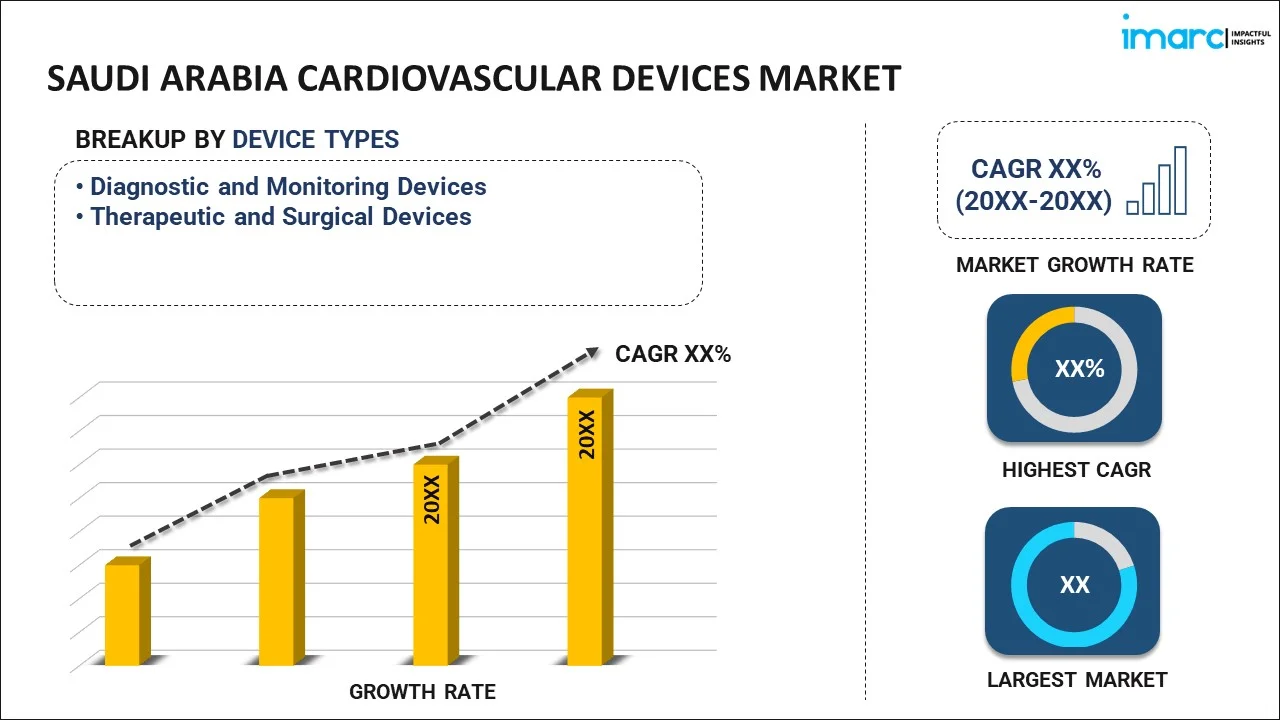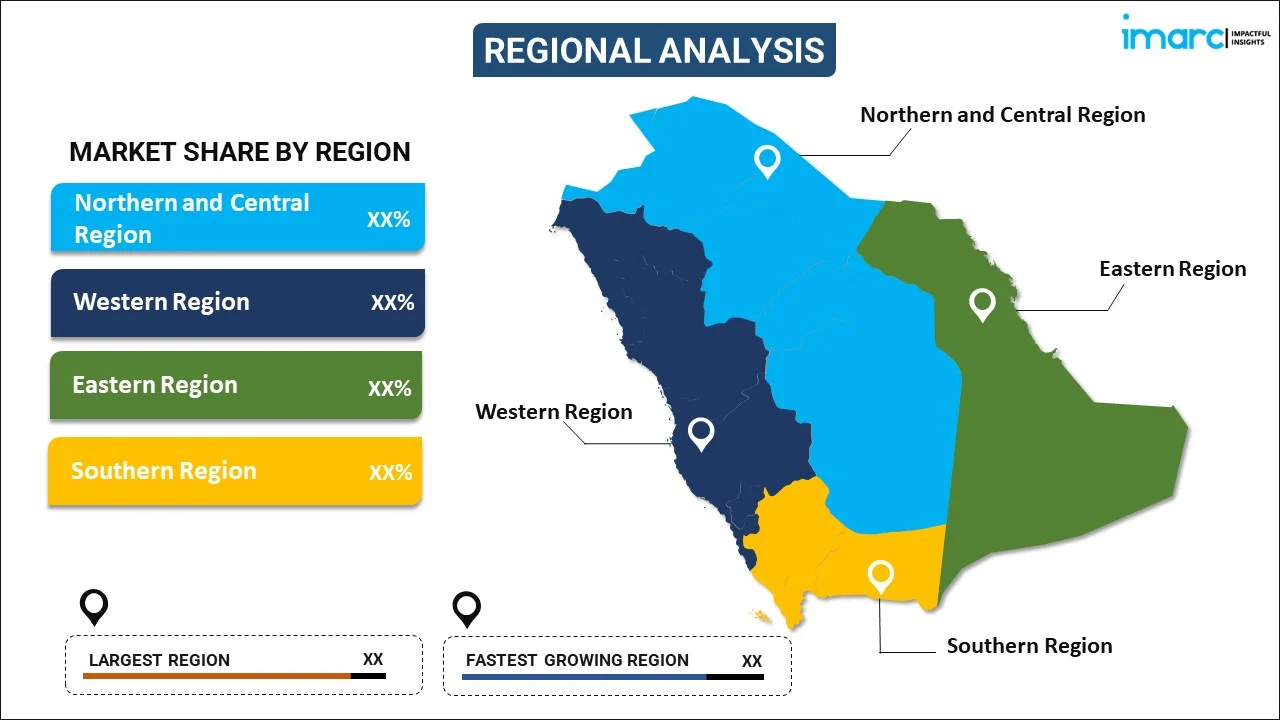
Saudi Arabia Cardiovascular Devices Market Report by Device Type (Diagnostic and Monitoring Devices, Therapeutic and Surgical Devices), Application (Coronary Artery Disease (CAD), Cardiac Arrhythmia, Heart Failure, and Others), End User (Hospitals, Specialty Clinics, and Others), and Region 2025-2033
Market Overview:
Saudi Arabia cardiovascular devices market size reached USD 578.2 Million in 2024. Looking forward, IMARC Group expects the market to reach USD 1,320.4 Million by 2033, exhibiting a growth rate (CAGR) of 9.6% during 2025-2033. The increasing prevalence of cardiovascular diseases in the region, the rising government's commitment to healthcare infrastructure development, and the development of wireless and remote monitoring cardiac devices represent some of the key factors driving the market.
|
Report Attribute
|
Key Statistics
|
|---|---|
|
Base Year
|
2024
|
|
Forecast Years
|
2025-2033
|
|
Historical Years
|
2019-2024
|
| Market Size in 2024 | USD 578.2 Million |
| Market Forecast in 2033 | USD 1,320.4 Million |
| Market Growth Rate 2025-2033 | 9.6% |
Cardiovascular devices are critical instruments and technologies used in the diagnosis, monitoring, and treatment of heart diseases and related health conditions. These devices encompass a wide array of products, including stents, pacemakers, defibrillators, catheters, electrocardiogram (ECG) machines, and surgical instruments specifically designed for cardiac procedures. Each device serves a distinct purpose: stents help keep arteries open, pacemakers and defibrillators regulate heart rhythm, and catheters are used in diagnostic procedures and treatments such as angioplasty. Additionally, ECG machines provide vital information on heart activity. The advantages of using these devices are manifold. They offer life-saving interventions, improve patient outcomes, and have become increasingly sophisticated, allowing for minimally invasive procedures and shorter recovery times. Their design and functionality are continuously evolving, integrating advanced technologies such as wireless connectivity and remote monitoring, enhancing patient care and convenience. As such, cardiovascular devices are essential in healthcare settings and pivotal in advancing cardiac care standards.
Saudi Arabia Cardiovascular Devices Market Trends:
In Saudi Arabia, the market for cardiovascular devices is witnessing significant growth, driven by the increasing prevalence of cardiovascular diseases in the region due to lifestyle factors such as sedentary habits, poor diet, and high smoking rates. This rise is accompanied by a growing awareness of heart health and the availability of advanced medical treatments. Along with this, the Saudi Arabian government's commitment to healthcare infrastructure development is leading to considerable investments in healthcare facilities, including specialized cardiac centers. This expansion facilitates the adoption of advanced cardiovascular devices. In addition, the country's aging population is another critical driver for the market. Moreover, older individuals are more susceptible to cardiac conditions, necessitating the need for cardiac care and the devices associated with it. Therefore, this is positively influencing the market. Apart from this, technological advancements in the field of cardiology, such as the development of wireless and remote monitoring cardiac devices, are enhancing patient management and care, further propelling market growth. In confluence with this, the trend towards minimally invasive procedures, offering quicker recovery and reduced hospital stays, also fuels the adoption of novel cardiovascular devices. Concurrently, the increased focus on research and development activities within the kingdom, aimed at innovating and improving cardiovascular devices, is contributing to the market. Furthermore, the rising healthcare expenditure and the government's supportive policies towards healthcare sector improvements are creating a positive market outlook. Some of the other factors driving the market include continuous technological advancements, changing consumer preferences, and the inflating disposable income levels of individuals.
Saudi Arabia Cardiovascular Devices Market Segmentation:
IMARC Group provides an analysis of the key trends in each segment of the market, along with forecasts at the country level for 2025-2033. Our report has categorized the market based on device type, application, and end user.
Device Type Insights:

- Diagnostic and Monitoring Devices
- Electrocardiogram (ECG)
- Remote Cardiac Monitoring
- Others
- Therapeutic and Surgical Devices
- Cardiac Assist Devices
- Cardiac Rhythm Management Devices
- Catheter
- Grafts
- Others
The report has provided a detailed breakup and analysis of the market based on the device type. This includes diagnostic and monitoring devices (electrocardiogram (ECG), remote cardiac monitoring, and others) and therapeutic and surgical devices (cardiac assist devices, cardiac rhythm management devices, catheter, grafts, and others).
Application Insights:
- Coronary Artery Disease (CAD)
- Cardiac Arrhythmia
- Heart Failure
- Others
A detailed breakup and analysis of the market based on the application have also been provided in the report. This includes coronary artery disease (CAD), cardiac arrhythmia, heart failure, and others.
End User Insights:
- Hospitals
- Specialty Clinics
- Others
The report has provided a detailed breakup and analysis of the market based on the end user. This includes hospitals, specialty clinics, and others.
Regional Insights:

- Northern and Central Region
- Western Region
- Eastern Region
- Southern Region
The report has also provided a comprehensive analysis of all the major regional markets, which include Northern and Central Region, Western Region, Eastern Region, and Southern Region.
Competitive Landscape:
The market research report has also provided a comprehensive analysis of the competitive landscape in the market. Competitive analysis such as market structure, key player positioning, top winning strategies, competitive dashboard, and company evaluation quadrant has been covered in the report. Also, detailed profiles of all major companies have been provided.
Saudi Arabia Cardiovascular Devices Market Report Coverage:
| Report Features | Details |
|---|---|
| Base Year of the Analysis | 2024 |
| Historical Period | 2019-2024 |
| Forecast Period | 2025-2033 |
| Units | Million USD |
| Scope of the Report | Exploration of Historical Trends and Market Outlook, Industry Catalysts and Challenges, Segment-Wise Historical and Future Market Assessment:
|
| Device Types Covered |
|
| Applications Covered | Coronary Artery Disease (CAD), Cardiac Arrhythmia, Heart Failure, Others |
| End Users Covered | Hospitals, Specialty Clinics, Others |
| Regions Covered | Northern and Central Region, Western Region, Eastern Region, Southern Region |
| Customization Scope | 10% Free Customization |
| Post-Sale Analyst Support | 10-12 Weeks |
| Delivery Format | PDF and Excel through Email (We can also provide the editable version of the report in PPT/Word format on special request) |
Key Questions Answered in This Report:
- How has the Saudi Arabia cardiovascular devices market performed so far and how will it perform in the coming years?
- What has been the impact of COVID-19 on the Saudi Arabia cardiovascular devices market?
- What is the breakup of the Saudi Arabia cardiovascular devices market on the basis of device type?
- What is the breakup of the Saudi Arabia cardiovascular devices market on the basis of application?
- What is the breakup of the Saudi Arabia cardiovascular devices market on the basis of end user?
- What are the various stages in the value chain of the Saudi Arabia cardiovascular devices market?
- What are the key driving factors and challenges in the Saudi Arabia cardiovascular devices?
- What is the structure of the Saudi Arabia cardiovascular devices market and who are the key players?
- What is the degree of competition in the Saudi Arabia cardiovascular devices market?
Key Benefits for Stakeholders:
- IMARC’s industry report offers a comprehensive quantitative analysis of various market segments, historical and current market trends, market forecasts, and dynamics of the Saudi Arabia cardiovascular devices market from 2019-2033.
- The research report provides the latest information on the market drivers, challenges, and opportunities in the Saudi Arabia cardiovascular devices market.
- Porter's five forces analysis assist stakeholders in assessing the impact of new entrants, competitive rivalry, supplier power, buyer power, and the threat of substitution. It helps stakeholders to analyze the level of competition within the Saudi Arabia cardiovascular devices industry and its attractiveness.
- Competitive landscape allows stakeholders to understand their competitive environment and provides an insight into the current positions of key players in the market.
Need more help?
- Speak to our experienced analysts for insights on the current market scenarios.
- Include additional segments and countries to customize the report as per your requirement.
- Gain an unparalleled competitive advantage in your domain by understanding how to utilize the report and positively impacting your operations and revenue.
- For further assistance, please connect with our analysts.
 Inquire Before Buying
Inquire Before Buying
 Speak to an Analyst
Speak to an Analyst
 Request Brochure
Request Brochure
 Request Customization
Request Customization




.webp)




.webp)












